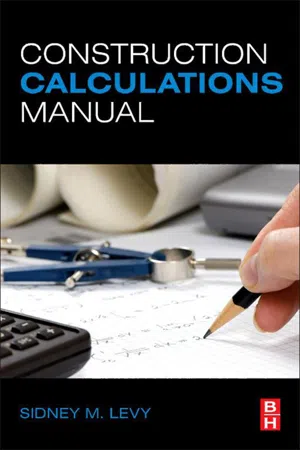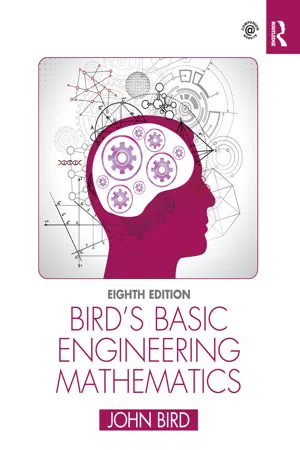Mathematics
Volume of Cone
The volume of a cone is the measure of space enclosed by a cone. It is calculated using the formula V = (1/3)πr^2h, where V represents the volume, π is a constant (approximately 3.14159), r is the radius of the base of the cone, and h is the height of the cone.
Written by Perlego with AI-assistance
Related key terms
7 Key excerpts on "Volume of Cone"
- eBook - ePub
Conceptual Maths
Teaching 'about' (rather than just 'how to do') mathematics in schools
- Peter Mattock(Author)
- 2023(Publication Date)
- Crown House Publishing(Publisher)
.Similarly, the volume of a cone can be found by treating it as analogous to a pyramid, being a third of the volume of the containing cylinder. However, it is more difficult to visualise this than with a square or rectangular pyramid (where we can show pyramids attached to the side of the prism as well as the base); however, there are nice video demonstrations that involve filling a cone-shaped container with water and pouring it into a cylindrical container with the same base circle (as demonstrated in the video linked below27 ).This leads to the volume of the cone formula being equal to πr2 h, or alternatively . One thing that pupils need to be clear on here is the use of the vertical height when calculating the volume of a cone, which is in contrast to the use of the slant height when calculating the curved surface area. Offering pupils opportunities to work with both of these is important to make sure pupils use the correct lengths in the correct situations.When it comes to finding the volume of the sphere, again typically calculus would be used to derive the formula; however, there are similar demonstrations to the one above: particularly showing that the sphere of radius r (and therefore diameter 2r) can be filled with a cone with height 2r (and therefore volume of πr3 ) twice over leading to the conclusion that the volume of the sphere can be calculated by πr3 .28 There is also a derivation of the formula that doesn’t require calculus, but does require Pythagoras’ theorem and a reasonable amount of geometric knowledge and insight. The proof rests around demonstrating that when a hemisphere is placed inside a cylinder with the same height and radius (as per the next image) it is possible to show that the space inside the cylinder outside of the hemisphere is equal to the space taken up by a cone with the same radius and height as the cylinder.389 - eBook - ePub
- Andre Castagna(Author)
- 2021(Publication Date)
- Barrons Educational Services(Publisher)
A circular cone is a solid with one circular base and a curved lateral surface that comes to a point at the apex. The height of the cone is the length of the segment from the apex perpendicular to the base. In a right circular cone, the height will intersect at the center of the circular base.Figure 12.4 Right circular coneVolume of a Circular Cone
where r is the radius of the base and h is the height.These formulas are applied in a manner similar to those for the cylinder. The Pythagorean theorem can be used to relate slant height, height, and radius. So if you know any two, you can find the third.Example
Jenna is planting a garden and has a pile of topsoil delivered to her house. A dump truck delivers the topsoil and dumps it in a pile that is cone shaped. The radius of the pile is 18 ft and the height is 12 ft. What is the volume of the pile? Round to the nearest tenth.Solution:Pyramids
A pyramid is a solid with one polygonal base and triangular lateral faces that meet at an apex. The height of the pyramid is the length of the segment from the apex perpendicular to the base. In a right pyramid, the height intersects at the center of the base. Figure 12.5 shows right pyramids with bases in the shape of a triangle and a rectangle.Figure 12.5Triangular and square-based pyramids with height hVolume of a Pyramid
where B is the area of the base and h is the height.Example
Find the volume of a 5 ft high right pyramid with a square base whose side length is 4 ft.Solution: First find the area of the base, which is a square.Now apply the volume formulaMath Fact
If the base of a pyramid is a regular polygon, then the lateral faces are all isosceles triangles.Spheres
A sphere, as shown in Figure 12.6, is the solid figure comprised of the set of all points a fixed distance (the radius) from a center point. The only dimension needed to define the volume and area of a sphere is its radius.Figure 12.6Sphere with radius rArea and Volume of a Sphere
Example
- Find the volume of a sphere whose diameter is 14 inches. Round to the nearest hundredth.
- Find the radius of a sphere whose volume equals 432.5 cm3
- eBook - ePub
- Sidney M Levy(Author)
- 2011(Publication Date)
- Butterworth-Heinemann(Publisher)
If you take any circle, measure its circumference and its diameter, and divide the circle's circumference by its diameter, the answer is always 3.1416. This ratio of the circumference to the diameter is always the same, regardless of the size of the circle or its units of measure.Volume of a cylinder
volume = (pi / 4) × a2 × b and volume = pi × a/2 × a/2 × bVolume of a frustum of a pyramid
Volume of a cone
Volume of a frustum of a cone
Frustum's surface area
Tangent Examples: tangent 30° = 0.57735 tangent 35° = 0.70021 tangent 40° = 0.83910 tangent 45° = 1.00000 tangent 50° = 1.19175 tangent 55° = 1.42815 tangent 60° = 1.73205 tangent 65° = 2.14451 tangent 70° = 2.74748Volume of a sphere
Area of a circle
A circle's area can be determined by using either the radius or the diameterCircumference of a circle
Volume of a pyramid
3.2.1 Volume of Prisms
Right Prism Volume Postulate
The volume V of any right prism is the product of B , the area of the base, and the height h of the prism.(The base's formula could change depending on the base's shape.)Formula:3.2.2 Volume of Pyramids
Pyramids
A pyramid is a polyhedron with a single base and lateral faces that are all triangular. All lateral edges of a pyramid meet at a single point, or vertex .Pyramid Volume Theorem
The volume V of any pyramid with height h and a base with area B is equal to one-third the product of the height and the area of the base.Formula:3.2.3 Area of Prisms and Right Area Prisms
There are special formulas that deal with prisms, but they only deal with right prisms. Right prisms - eBook - ePub
- John Bird(Author)
- 2021(Publication Date)
- Routledge(Publisher)
A cone of base radius r and perpendicular height h is shown in Fig. 28.11 Volume = 1 3 × area of base ×perpendicular height Figure 28.11 i.e. V o l u m e = 1 3 π r 2 h C u r v e d s u r f a c e a r e a = π r l T o t a l s u r f a c e a r e a = π r l + π r 2 Problem 12. Calculate the volume, in cubic centimetres, of a solid wooden cone of radius 30 mm and perpendicular. height 80 mm Volumeofcone = 1 3 π r 2 h = 1 3 × π × 30 2 × 80 = 75398.2236 … mm 3 1 cm = 10 mmand 1 cm 3 = 10 mm × 10 mm × 10 mm = 10 3 mm 3, or 1 mm 3 = 1 0 − 3 cm 3 Hence, 75398.2236 … mm 3 = 75398.2236 … × 10 − 3 cm 3 i.e. v o l u m[--=P. LGO-SEPARATOR=--]e = 7 5. 4 0 c m 3 Alternatively, from the question, r = 30 mm = 3 cm and h = 80 mm = 8 cm. Hence, v o l u m e = 1 3 π r 2 h = 1 3 × π × 3 2 × 8 = 7 5. 4 0 c m 3 Problem 13. Determine the volume and total surface area of a metal cone of radius 5 cm and perpendicular height 12 cm The cone is shown in Fig. 28.12. Figure 28.12 V o l u m e o f c o n e = 1 3 π r 2 h = 1 3 × π × 5 2 × 12 = 3 1 4. 2 c m 3 Total surface area = curved surface area + area of base = π r l + π r 2 From Fig. 28.12,slant height l may be calculated using Pythagoras’ theorem: l = 12 2 + 5 2 = 13 cm Hence, t o t a l s u r f a c e a r e a = (π × 5 × 13) + (π × 5 2) = 2 8 2. 7 c m 2 Spheres For the sphere shown in Fig. 28.13 : V o l u m e = 4 3 π r 3 and s u r f a c e a r e a = 4 π r 2 Figure 28.13 Problem 14. Find the volume and surface area of a spherical shot put of diameter 10 cm Since. diameter = 10 cm, radius, r = 5 cm V o l u m e o f s p h e r e = 4 3 π r 3 = 4 3 × π × 5 3 = 5 2 3. 6 c m 3 S u r f a c e a r e a o f s p h e r e = 4 π r 2 = 4 × π × 5 2 = 3 1 4[--=PLGO-SEPARATOR=-. -]. 2 c m 2 Problem 15. The surface area of a spherical cannon ball is 201.1 cm 2. Find the diameter of the cannon ball and hence its volume Surface area of sphere = 4 π r 2 Hence, 201.1 cm 2 = 4 × π × r 2 from which r 2 = 201.1 4 × π = 16.0 and radius, r = 16.0 = 4.0 cm from - eBook - ePub
- W Bolton(Author)
- 2012(Publication Date)
- Routledge(Publisher)
and we can write:where k is a constant. The volume V of the frustum is the volume of the whole pyramid minus the volume of the part removed. Thus:The surface area of the frustum of a pyramid is the sum of the areas of the trapeziums forming the sides plus the areas of the top and the base.The volume V of the frustum of a cone (Figure 2.23 ) can be determined using the above equation with A = πR2 and a = πr2 , where R is the radius of the base and r the radius of the cut surface, as:Figure 2.23 ConeThe area of the curved surface of the cone is the area of the curved surface of the original cone minus the curved surface of the cut-off cone:area of curved surface = πR(l + x) - πrx = ΠRL + π(R - r)xSince r/x = R/(l + x) then rl + rx = Rx and so x = rl/(R - r). Hence:The total surface area of the frustum of the cone is thus the area of the curved surface plus the areas of the two end faces:total surface area = πl(R + r) + πR2 + πr2Example Determine the volume and area of the curved surface of the frustum of a cone if the diameter of the ends are 160 mm and 70 mm and its perpendicular height is 30 mm.RevisionArea of curved surface = πl(R + r)Since, using the Pythagoras theorem, l2 = h2 + (R - r)2 = 302 + 152 then l = 33.5 mm and so:area of curved surface = π × 33.5(80 + 35) = 1.2 × 104 cm2ExampleA hopper is in the shape of a frustum of a square-based pyramid. Determine its volume if the ends of the frustum are squares of sides 6.0 m and 4.2 m respectively and the perpendicular height is 3.5 m.The hopper has the shape shown in Figure 2.22 . Its volume V is:9 Determine the volume of the frustum of a prism which has a rectangular base 80 mm by 120 mm, an upper rectangular surface 30 mm by 45 mm and a vertical height of 80 mm.10 - eBook - ePub
- Frank R. Spellman(Author)
- 2023(Publication Date)
- CRC Press(Publisher)
volume. V = L × π r 2 = 300 ft × 3.14 × 0.0156 = 14.72 ft 2 Example 3.50 Problem: Find the volume of a smokestack that is 24 in diameter (entire length) and 96 in tall. Find the radius of the stack. The radius is one-half the diameter. 24 in ÷ 2 = 12 in Find the volume. Solution: V = H × π r 2 = 96 in × π (12 in) 2 = 96 in × π (144 in 2) = 43, 407 ft 3 To determine the volume of a cone and sphere, we use the following equations and examples. Volume of Cone = π 12 × diameter × diameter × height π 12 = 3.14 12 = 0.262 (3.10) Key point : The diameter used in the formula is the diameter of the base of the cone. Example 3.51 Problem: The. bottom section of a circular settling tank has the shape of a cone. How many cubic feet of water are contained in this section of the tank if the tank has a diameter of 120 ft and the cone portion of the unit has a depth of 6 ft? Solution: Volume, ft 3 = 0.262 × 120 ft × 120 ft × 6 ft = 22, 637 ft 3 Volume of sphere = 3.14 6 × diameter × diameter × diameter π 6 = 3.14 6 = 0.524 (3.11) Example 3.52 Problem: What is the volume of cubic feet of a gas storage container that is spherical and has a diameter of. 60 ft? Solution: Volume, ft 3 = 0.524 × 60 ft × 60 ft × 60 ft = 113, 184 ft 3 Circular process and various water/chemical storage tanks are commonly found in water/wastewater treatment. A circular tank consists of a circular floor surface with a cylinder rising above it (see Figure 3.9). The volume of a circular tank is calculated by multiplying the surface area times the height of the tank walls. FIGURE 3.9 Circular or cylindrical water tank. Example 3.53 Problem: If a tank is 20 ft in diameter and 25 ft deep, how many gallons of water will it hold? Hint : In this type of problem, calculate the surface area first, multiply by the height, and then convert it to - eBook - ePub
- John Bird(Author)
- 2019(Publication Date)
- Routledge(Publisher)
Chapter 14 Volumes of common solidsWhy it is important to understand: Volumes of common solidsThere are many practical applications where volumes and surface areas of common solids are required. Examples include determining capacities of oil, water, petrol and fish tanks, ventilation shafts and cooling towers, determining volumes of blocks of metal, ball-bearings, boilers and buoys, and calculating the cubic metres of concrete needed for a path. Finding the surface areas of loudspeaker diaphragms and lampshades provide further practical examples. Understanding these calculations is essential for the many practical applications in engineering, construction, architecture and science.At the end of this chapter, you should be able to:- state the SI unit of volume
- calculate the volumes and surface areas of cuboids, cylinders, prisms, pyramids, cones and spheres
- appreciate that volumes of similar bodies are proportional to the cubes of the corresponding linear dimensions
14.1 Introduction
The volume of any solid is a measure of the space occupied by the solid. Volume is measured in cubic units such as mm3 , cm3 and m3 .This chapter deals with finding volumes of common solids; in engineering it is often important to be able to calculate volume or capacity, to estimate, say, the amount of liquid, such as water, oil or petrol, in differently shaped containers.A prism is a solid with a constant cross-section and with two ends parallel. The shape of the end is used to describe the prism. For example, there are rectangular prisms (called cuboids), triangular prisms and circular prisms (called cylinders).On completing this chapter you will be able to calculate the volumes and surface areas of rectangular and other prisms, cylinders, pyramids, cones and spheres. Volumes of similar shapes are also considered.14.2 Calculating volumes and surface areas of common solids
Science and Mathematics for Engineering. 978-0-367-20475-4, © John Bird. Published by Taylor & Francis. All rights reserved.14.2.1 Cuboid or rectangular prism
Learn about this page
Index pages curate the most relevant extracts from our library of academic textbooks. They’ve been created using an in-house natural language model (NLM), each adding context and meaning to key research topics.






